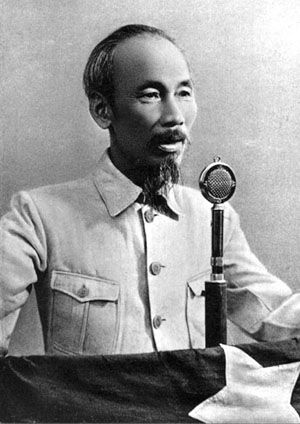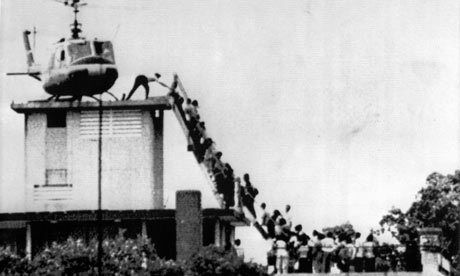After the War of Independence in Indochina, Vietnam, Laos and Cambodia gained official independence in 1954.
Vietnam was divided in two at this time: South Vietnam and North Vietnam. There were no plans to reunite the two regions. On October 23, 1955, South Vietnam formed a new republic. Due to fear of possible electoral fraud, the government refused to hold a vote on the reunification of Vietnam.
The US government supported the ruling military power in Saigon, the capital of South Vietnam. The United States provided direct economic aid and also trained military forces. Diem led the authoritarian government in Saigon. Only one political party was in power and it exercised strong police and armed repression.
The government of North Vietnam, based in Hanoi, still hoped for reunification. Led by Ho Chi Minh, North Vietnam was a communist state.

Hô Chi Minh
A far left movement started in 1959, created by Vietnamese who were frustrated by the Diem dictatorship: The National Liberation Front (NLF) or Viet Cong. The NLF attempted to overthrow the Saigon government. This attempted coup marked the beginning of the conflict between South Vietnam and North Vietnam.
Diem and his brother were assassinated on November 1, 1963. The US army, still allied with South Vietnam, participated in the conflict and sent troops to increase pressure on the communist regime. This was especially important after the assassination of President Kennedy, who had planned to withdraw US troops from Vietnam.
The conflict gradually grew. After the Tonkin Gulf Resolution, the US government authorized the use of any military resources that could bring peace to Vietnam. At the end of 1965, there were 80 000 US soldiers in Vietnam launching offensive missions. The strategy aimed to weaken communist forces but it resulted in significant impacts on Vietnamese civilians.
Ho Chi Minh incited the population of the South to rebel against this foreign power. In 1967, the armies of North Vietnam perpetrated massive attacks on American bases.
On January 31, 1968, 85 000 NLF soldiers attacked cities and military bases in the South.
There was more and more pressure on the United States, especially after a massacre that caused the death of 500 Vietnamese. Also in 1968, Richard Nixon was elected and promised to achieve peace with honour in Vietnam and to evacuate all armies from South Vietnam. North Vietnam saw this as an opportunity to chase the US out of South Vietnam. The army of the South, without the US forces, could not defend themselves.
Nixon then sent new US troops to Laos and Cambodia to eliminate the North Vietnamese forces there. This decision was met with much criticism in the United States.
In the face of this criticism, Nixon ended the Tonkin Gulf Resolution and said that the United States would no longer send troops outside of Vietnam. At the beginning of 1972, there were only 6000 US soldiers in Vietnam. On June 30, 180 000 Vietnamese communists attacked and won the battle. The United States responded with aerial attacks on strategic targets.
Nixon wanted to end the war before the new election. He made a number of concessions but these did not result in any agreement or signings. Nixon ended all actions in Vietnam in January 1973 following a number of outside conflicts and the Watergate political scandal.
The peace treaty was signed on January 27, followed by the end of the war and the evacuation of the last US soldiers in March. The peace treaty led to the liberation of all prisoners, the evacuation of all US soldiers, the end of operations in Laos and Cambodia, the establishment of a Reconciliation Council and US financial aid to South Vietnam. Vietnam was officially reunited on June 24, 1976.

Évacuation